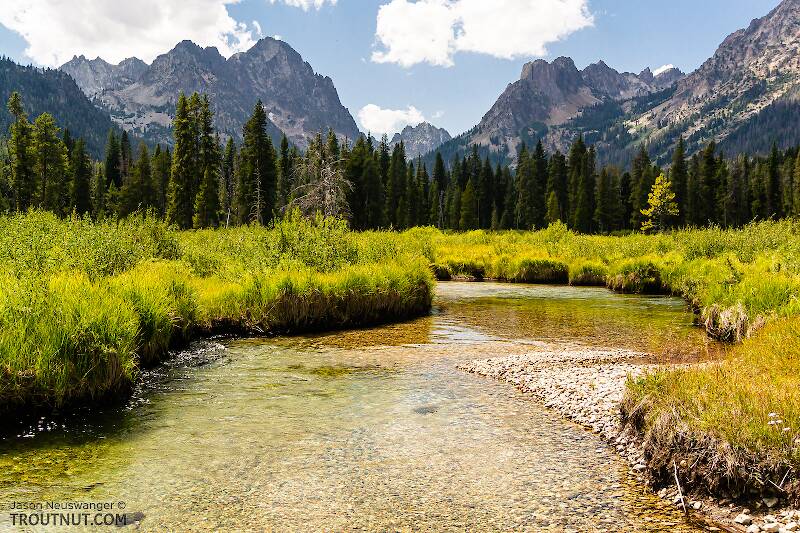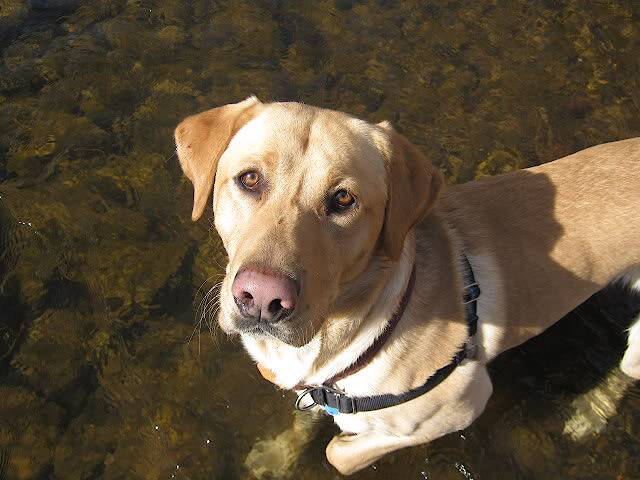
Blue-winged Olives
Baetis
Tiny Baetis mayflies are perhaps the most commonly encountered and imitated by anglers on all American trout streams due to their great abundance, widespread distribution, and trout-friendly emergence habits.
Featured on the forum


Troutnut is a project started in 2003 by salmonid ecologist Jason "Troutnut" Neuswanger to help anglers and
fly tyers unabashedly embrace the entomological side of the sport. Learn more about Troutnut or
support the project for an enhanced experience here.
WestCO on Sep 17, 2012September 17th, 2012, 5:20 pm EDT
I just fell into one. For the rivers I fish, a 4 wt is considered to be even a bit bulky, and I use my 6 wt when I throw streamers. I usually use a 3 wt for single dry fishing. Has anyone ever used a 5 wt in any exclusive manner? I'm just curious as to what benefits it provides, or if it has any sort of a niche.
...but fishermen I have noticed, they don't care if I'm rich or poor, wearing robes or waders, all they care about is the fish, the river, and the game we play. For fishermen, the only virtues are patience, tolerance, and humility. I like this.
Sayfu
Posts: 560
Posts: 560
Sayfu on Sep 17, 2012September 17th, 2012, 5:25 pm EDT
Pleasure of the user. I've got 3wts. to 8 wts. for trout, and like to use all of them. I can pick up a 5wt. and use it just as well as a 4 wt. or a 6wt. The action, or the flexibility means as much to me as the suggested line wt.
PaulRoberts on Sep 17, 2012September 17th, 2012, 5:43 pm EDT
For the teaching of beginners I've done, considering where I've lived and what we fish for, I usually suggest a 5wt for their first all around rod. Light enough for trout, just hefty enough to throw some split shot for nymphing or for light warmwater stuff, say for smallmouths, small largemouths and panfish. And a good line to buck some wind too.
For my own stream trout fishing, I like fast powerful rods, so most often fish a ~5wt rod coupled with a 4wt line. I may actually use a 5wt line at times, esp when brush-bucking: Using the added line weight to punch through light vegetation, like overhanging leaves shrouding inviting nooks and crannies.
Today I dropped to a 3wt bc I was hitting a stream with beaver ponds and the lighter line simply makes less commotion. But a good breeze popped up, reminding me I was throwing a 3.
During winter I often jump right up to a 6wt bc of the heavier shot I use to cut those viscous winter flows. I'd rather use a 5 than a 4 for nymphing in winter, and often a 6 over a 5.
For my own stream trout fishing, I like fast powerful rods, so most often fish a ~5wt rod coupled with a 4wt line. I may actually use a 5wt line at times, esp when brush-bucking: Using the added line weight to punch through light vegetation, like overhanging leaves shrouding inviting nooks and crannies.
Today I dropped to a 3wt bc I was hitting a stream with beaver ponds and the lighter line simply makes less commotion. But a good breeze popped up, reminding me I was throwing a 3.
During winter I often jump right up to a 6wt bc of the heavier shot I use to cut those viscous winter flows. I'd rather use a 5 than a 4 for nymphing in winter, and often a 6 over a 5.
Sayfu
Posts: 560
Posts: 560
Sayfu on Sep 18, 2012September 18th, 2012, 5:34 am EDT
What has thrown the whole thinking of rod wts. out of wack is the new modern graphite rods. The old thinking, for instance, was a 3wt. was to be used for small flies, and close in work. Now, you can buy a 9 ft. 3wt, and throw a big bushy fly out there 70 ft. if you are a good caster. But the biggest sales for all around work for trout has been reported to be the 5wt rod. Years ago it was the 6 wt. before the advent of good genetic hackle, good small hooks and small flies anyway, and again, the advent of modern rod technology.
PaulRoberts on Sep 18, 2012September 18th, 2012, 7:05 am EDT
Yeah, things have changed ... or evolved. The original formula still holds, or should, just to set some standard, and that is the weight a rod blank can support at a certain distance. I think the standard is/was 30ft.
Such latitude is taken now that, for distance, instead of just owners underlining, rod makers down-label. I have an older T&T "2wt" I comfortably throw a 4 on for all but longest of casting. My T&T "5 wt" throws a 6 best at "normal ranges" but with a 5 I can throw the whole line without thinking, or cut the wind. My Batson "XF 4wt" would throw a 5 just fine. It rips a 4 though -just what I bought it for.
When one buys a rod they need to decide what its purpose is -where and how it'll be used. It does help to cast a rod before purchase. Otherwise you have to negotiate the rather cryptic descriptions provided for rods by manufacturers: "delicate", "forgiving", "western", "punching into the wind", ...
Such latitude is taken now that, for distance, instead of just owners underlining, rod makers down-label. I have an older T&T "2wt" I comfortably throw a 4 on for all but longest of casting. My T&T "5 wt" throws a 6 best at "normal ranges" but with a 5 I can throw the whole line without thinking, or cut the wind. My Batson "XF 4wt" would throw a 5 just fine. It rips a 4 though -just what I bought it for.
When one buys a rod they need to decide what its purpose is -where and how it'll be used. It does help to cast a rod before purchase. Otherwise you have to negotiate the rather cryptic descriptions provided for rods by manufacturers: "delicate", "forgiving", "western", "punching into the wind", ...
WestCO on Sep 18, 2012September 18th, 2012, 7:49 pm EDT
My favorite rod is a 3 wt 7'10 and I think it could be said that the length has more to do with why I like it than the weight, however there's something about the tip that just does it for me. I feel like I could tap a fish on the head with ease.
I am a high school baseball coach and some of my fondest memories of fly fishing as a kid were other baseball coaches taking me to the river. So perhaps I'll take your advice and use it as a good starter rod for a kid. Thanks!
I am a high school baseball coach and some of my fondest memories of fly fishing as a kid were other baseball coaches taking me to the river. So perhaps I'll take your advice and use it as a good starter rod for a kid. Thanks!
...but fishermen I have noticed, they don't care if I'm rich or poor, wearing robes or waders, all they care about is the fish, the river, and the game we play. For fishermen, the only virtues are patience, tolerance, and humility. I like this.
Sayfu
Posts: 560
Posts: 560
Sayfu on Sep 19, 2012September 19th, 2012, 8:10 am EDT
Waters that you fish are a major factor. I fish big, boatable rivers a lot, and making short, accurate casts to the bank is needed at times, and then getting out, and wading a riffle laying out 40 to 50 ft of line, and being able to mend well with a 9 ft. rod is needed winging soft hackles. I have a 7.5 4wt for my small fly close in work, but it doesn't get the use my 9 fters get throwing big bushy attractor patterns.
PaulRoberts on Sep 19, 2012September 19th, 2012, 11:01 am EDT
It's tough trying to play 18 holes of golf with one club. Fishing is similar. If I had to choose one club, it would be a 5 or 6 iron.
Sayfu
Posts: 560
Posts: 560
Sayfu on Sep 19, 2012September 19th, 2012, 11:36 am EDT
Twer I, I would chose a putter, cus I can hit a ball with a putter as far as I can with a driver!
Quick Reply
Related Discussions
Topic
Replies
Last Reply
2
May 17, 2018
by Subway
by Subway



